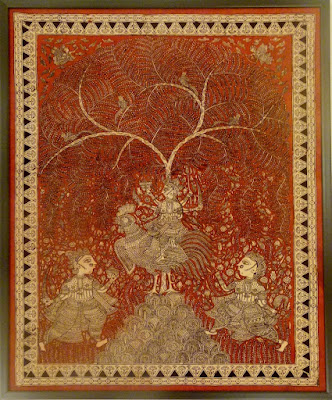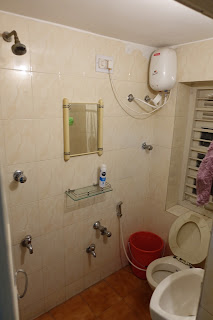It has been a while, ok a long while, so I figured I should
do another posting. Progress has honestly been slow, but this week I am hoping
to make some real progress.
One of the pieces I will be making is a 3-legged stool, the
legs will be lathe turned by Anil in Dholka and the circular top will be
upholstered in a fabric made by one of the very few Mata ni pachedi makers in
India.
Mata ni pachedi literally translates to “behind the mother
goddess” and the “true” mata ni pachedi cloth constitutes a temple of the
goddess. The story goes that the nomadic Vaghari peoples of Gujarat were not
allowed into the temples, so they made their own in the form of the sacred mata
ni pachedi cloth.
When I was considering early on which craft forms to work
with, I recognized that it would be very important to respect the sanctity of
the form and not in anyway knowing or unknowingly disrespect religion or
culture. It would be profoundly disrespectful to have a seat cushion made with
images of an extremely important Hindu deity on it. With that, the artist be using non-secular
designs in these pieces.
 |
| Traditional red & black cloth |
I had considered this early on when reviewing the various
crafts, for many of then are connected to religion. The mata ni pachedi, and
the metal shrines are two examples. This concern was confirmed by the mata ni
pachedi makers when they told me that they would not be willing to use any
mother goddess imagery on these cloths. I also think they were relieved when I
fully concurred.
These artisans are using the same intricate and time
consuming processes their ancestors have used for over some 200 years. It
begins with washing the cotton cloth, removing the starch and then treating
with a paste to help the cloth retain the applied colors. Only natural dyes are
used; iron for black, tamarind for red, indigo -blue, the green from henna,
& the yellow from turmeric. The main colors of a traditional cloth are red,
black and white but the other colours are commonly used. The designs begin with
outlining the design using bamboo “quills” or kalim, then the red is filled in
and the cloth is boiled in a solution to fix the colour. Each subsequent colour
is filled in and the cloth is boiled between each. Finally the cloth is washed
under running water, traditionally washed in the river.
 |
| Vasant with his daughter holding a new cloth done with traditional motif. |
 |
| Love love love this piece. |
I am having four cloths made; one using traditional motifs
including human figures (no mother goddess), another using traditional abstract
motifs, a third with fish, and the final will be a cloth displaying modern India;
rickshaws, airplanes, buses, camel carts, etc. I traveled to the makers a
couple days ago to see how work was going and at that time they were just finishing
up the outlining of the first two cloths; fish and traditional figures and they
are absolutely stunning! I am quite excited to see the last two and to see how
they all come out. I am working with Vasant Chitara along with his wife. They
are very kind and amazingly talented people, and they are training their
children to carry on the family tradition.
 | ||
| Traditional motif |
 |
| Fish! |
I am quite excited about this particular project. I feel
this truly frames one of the most stunning art forms being produced in India
today.



































